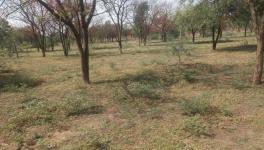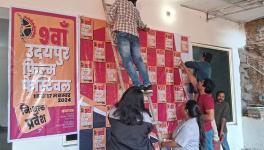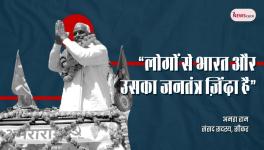Why Pehlu Khan’s Lynching, Murder Case Failed to Stand Judicial Scrutiny
New Delhi: The acquittal of six accused in Pehlu Khan’s brutal lynching and murder case is apparently an example of “monumental inefficiency” of the police or a “deliberate attempt to weaken the cases against the self-proclaimed ‘gau rakshaks’ [cow vigilantes],” who – according to legal luminaries – are “storm troopers” from Hitler’s Germany. A number of lawyers NewsClick spoke with – who refused to be named – said the investigators “weakened” the probe by “delaying filing of the FIR and invoking IPC sections of crimes with lesser punishment”.
Khan (55), a resident of Jaisinghpur village in Haryana, was lynched by cow vigilantes in Alwar while he was returning home after purchasing two cows and two calves from a Jaipur cattle fair. The murder caught national attention and Khan became the face of protests against the spate of lynchings across the country in the name of ‘gau raksha’ or cow protection.
GLARING LOOPHOLES IN POLICE INVESTIGATION
1. The alleged cover-up began with the first information report (FIR), which said the attack took place at 7 pm on April 1, 2017 and continued till 10 pm on that fateful day. The police registered an FIR at 4:24 am on April 2 after a delay of nine-and-a-half hours, even though the crime spot was only 2 km away from the police station. The FIR claimed the police were informed of the attack at 3:54 am on April 2.
Interestingly, the FIR contradicted itself on when the police received the information. Khan, in his statement given to the police before his death, said that the cops rushed him and other victims to the hospital (Kailash Hospital) from the scene of the crime on April 1. The “final report” that the police filed on May 31 (with the chargesheet in the court of Additional Chief Judicial Magistrate (ACJM) at Alwar district’s Behror tehsil, the jurisdiction in which the crime occurred), recorded that Khan gave his statement to the police at 11:50 pm on April 1 in the hospital, the same night following the attack.
Now, the question is: if the cops learnt of the incident at 3:54 am, as mentioned in the FIR, how did they bring the victims to the hospital and record his statement previously at around 11:50 pm?
2. If, as the victim claimed, the cops were present at the crime scene and took him to the hospital, why did the FIR not mention the names of the policemen and why weren’t they made witnesses in the case?
It was, in fact, the police who had brought Khan and his son to the hospital half an hour after the lynching took place on April 1. But the FIR does not name the policemen as witnesses. Their statements were not even recorded in the FIR. They failed to arrest any of the perpetrators from the crime scene.
3. Kailash Hospital is only 2.9 km from the police station, Behror. Yet, it took the cops four hours after recording Khan’s statement at 11:50 pm to making an entry in the general diary at 3:54 am.
4. Khan named six people (Om Yadav, Hukum Chand Yadav, Sudhir Yadav, Jagmal Yadav, Naveen Sharma and Rahul Saini) as attackers. But the FIR does not mention their names in the column “details of known/suspected/unknown accused with full particulars”.
5. Station House Officer (SHO) Ramesh Sinsinwar, who did not witness the crime, was the “complainant” in the FIR. If the police already had a statement of the victim, why was he not named as the complainant?
6. Pehlu Khan had named the six as his assailants as well as the right-wing organisations that they worked for. The police ignored the dying declaration and gave a clean chit to all six.
7. The alibi that the six people who were named came up with, was that they were at a ‘gaushala’ (cow shed) at the time of the lynching. Coincidentally, one of the accused is the caretaker of the ‘gaushala’ and the eyewitnesses to the alibi are all employees of the caretaker.
8. The six also said in their alibi that their mobile phones were not at the crime scene. The police chose to take this as conclusive evidence.
9. The six men, as the police claimed, were absconding for five months. Apart from announcing a reward of Rs 5,000 for information on their whereabouts, it is not known if the police conducted any raids, not only at the residences of the six men but also at those of their relatives and friends, as well as at their possible hideouts.
Surprisingly, the six accused mysteriously appeared before the cops when called and recorded their statements that they were not at the crime scene.
Also read: Our Muslim Identity Is Making It Difficult For Us To Get Justice, Says Pehlu’s Son Arif Khan
10. Three government doctors at Behror said the death was due to injuries sustained during the attack. The police chose to overlook the report by the government doctors and instead relied upon the testimony of doctors at a private Kailash Hospital, which coincidentally belongs to the then Union Minister Mahesh Sharma.
Dr DV Sharma, a surgeon at Kailash Hospital, said the condition of Pehlu was good when he was brought to the hospital, but his nose was bleeding and he was complaining of chest pain. On the basis of the chest pain complaint, it was concluded that he died of a heart attack. Sharma’s statement has contradictions. He said when Pehlu was brought to the hospital, he had normal breathing, but at the same time, the doctor said the victim was put on artificial oxygen supply, as he had problem in breathing.
Dr RC Yadav, a radiologist in the hospital, said – based on the X-ray and ultra sonography reports – the victim’s four ribs on both the sides (right and left) each were broken. But later, he said in his statement that there were no fractures in his ribs.
The police presented before the court two postmortem reports (one issued by the government hospital and the other by Kailash Hospital) along with the chargesheet. The government doctors’ report said the victim died of internal injuries caused by the beating, while the Kailash Hospital’s report said the victim died of heart attack.
11. In their bizarre findings, the doctors at Kailash Hospital said Khan was admitted to the hospital with fractured ribs, bleeding from the nose and other internal injuries. They also said he was complaining of pain in the chest. But at the same time, they said he was fine. They concluded that he died of heart attack.
If Khan was fine, why did he visit the hospital? Which healthy man would go visiting a hospital?
12. It is clear that Khan’s severe beating led to his death. But the police did not invoke Section 307 (attempt to murder) of the Indian Penal Code (IPC) that prescribes imprisonment of 10 years to life. Instead, the FIR invoked Sections 143 (being a member of an unlawful assembly) that prescribes an imprisonment of up to six months, 308 (attempt to commit culpable homicide not amounting to murder) that prescribes imprisonment of three to seven years, 323 (causing hurt) that has provisions of imprisonment of up to one year and a fine of Rs 1,000, 341 (wrongful restraint) that attracts an imprisonment of up to one month and a fine of Rs 500, 379 (theft) that prescribes an imprisonment of up to three years and 427 (mischief causing damage worth at least Rs 50) that prescribes an imprisonment of two years. Except for Sections 308 and 379, all are bailable. The chargesheet added Section 302 for murder, also non-bailable.
Yet, the arrested accused secured bail as the prosecution failed to defend the charges and the arrests at the Rajasthan High Court.
13. Several IPC sections that fit the offences in this case, were ignored in the FIR/charge-sheet. These include 120B (criminal conspiracy for an offence that is punishable with death), 307 (attempt to murder), 34 (crime committed by several people in furtherance of common intention), 148 (rioting armed with a weapon of offence likely to cause death), 149 (every member of unlawful assembly equally guilty of the offence committed), 153A (promoting enmity on grounds of religion), 204 (destruction of evidence), 396 (committing dacoity with murder), 397 (committing dacoity with attempt to cause death), 399 (making preparation to commit dacoity and 402 (assembling for the purpose of committing dacoity).
14. Two FIRs were filed in this case – one, against the alleged killers and, two, against the deceased and his son Irshad under sections 5, 8 and 9 of the Rajasthan Bovine Animal (Prohibition of Slaughter & Regulation of Temporary Migration or Export) Act, 1995. The chargesheet against the victim-son duo was also filed on May 24, 2019. But the police – after getting approval to go ahead in this case – said they will re-investigate the matter. Pehlu’s son is out on bail.
The then state government (led by Chief Minister Vasudhara Raje of the Bharatiya Janata Party) submitted its report in Khan’s lynching case to the Union Ministry of Home Affairs on April 7, 2017, following which a team was constituted to nab the culprits.
The Rajasthan Police suddenly changed the investigation officer, who was probing the case, on May 11, 2017. The probe was handed over to additional superintendent of police (Jaipur rural) from deputy superintendent of police (Alwar). Again the case was transferred to CB-CID in just two months on July 9, 2017.
The CB-CID gave a clean chit to all the six accused who were named by the deceased in his dying declaration.
Over two years after the incident, a Sessions Court in Rajasthan’s Alwar district on August 14 acquitted all the six accused giving them “benefit of doubt” in absence of sufficient evidence. The court rejected the video clips of the incident presented by the prosecution as “clinching evidence”. The police – on the basis of the video footage and other evidence, had nabbed six men — Bhim Rathi,Yogesh Kumar aka Dholia, Dayaram, Ravindra Kumar and Vipin Yadav — charging them under Sections 143 (unlawful assembly), 323 (voluntarily causing hurt), 341 (wrongful restraint), 302 (murder), 308 (culpable homicide), 379 (theft) and 427 (destruction of property) of the Indian Penal Code (IPC).
Three juveniles were also arrested by the police who are being tried by the Juvenile Justice Board.
Notably, the six accused who were cleared of all charges (Section 143 – unlawful assembly, 323 -voluntarily causing hurt, 341 – wrongful restraint, 302 – murder, 308 – culpable homicide, 379 – theft, and 427 – destruction of property) on August 14 were not those who were named by the deceased in his dying declaration.
The court rejected the video footage of the incident as it was not sent for forensic examination and also the police failed to seize the device, using which the video footage was recorded. The person who claimed that he had recorded the video could not satisfy the court when asked about the details and circumstances.
15. The identification parade of the accused were not performed in jail and therefore, the court said the witnesses cannot be relied upon. Pehlu’s son Irshan could not identify the accused in the court.
The court also rejected a prayer to take the video footage of a sting operation in which the accused are confessing to their crime as admissible evidence. The court rejected a prayer filed under Section 319 of CrPC to summon the reporter as witness to depose before the court.
Also read: No One Killed Pehlu Khan
Get the latest reports & analysis with people's perspective on Protests, movements & deep analytical videos, discussions of the current affairs in your Telegram app. Subscribe to NewsClick's Telegram channel & get Real-Time updates on stories, as they get published on our website.
























